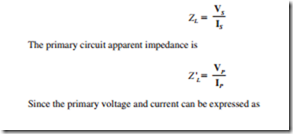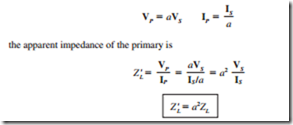 IMPEDANCE TRANSFORMATION THROUGH A TRANSFORMER
IMPEDANCE TRANSFORMATION THROUGH A TRANSFORMER
The impedance of a device is defined as the ratio of the phasor voltage across it to the phasor current flowing through it.
Since a transformer changes the current and voltage levels, it also changes the impedance of an element. The impedance of the load shown in Fig. 3.3b is
It is possible to match the magnitude of load impedance to a source impedance by simply selecting the proper turns ratio of a transformer.
Related posts:
INTRODUCTION TO LEARNING ABOUT ELECTRONICS FOR YOUR OWN GOOD
STEPPING MOTORS:DRIVE CIRCUITS AND PULL-OUT TORQUE–SPEED CURVES
Developing a Wiring Digram (Circuit #1)
POWER ELECTRONICS, RECTIFIERS, AND PULSE-WIDTH MODULATION INVERTERS:PULSE SYNCHRONIZATION AND VOLTAG...
Basic troubleshooting principles:Accurate wiring of circuits and connections
Troubleshooting AC motors and starters:Operating a motor for forward and reverse operation
Transformer,three phase:Instrument Transformers
Overload relays:Overloads
Resistive AC Circuits:Power in ac circuits
Timing relays:Electronic Timers
Representation of Audio Signals:Other Binary Operations
Manual starters:Manual Push-Button Starters
Analysis of Control Circuits
Software for Electronics:Productivity Software for electronics

